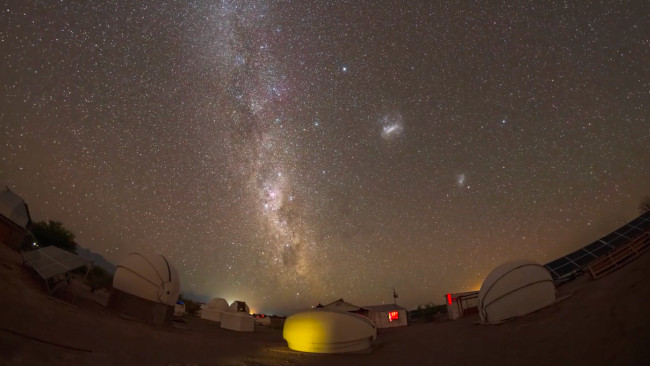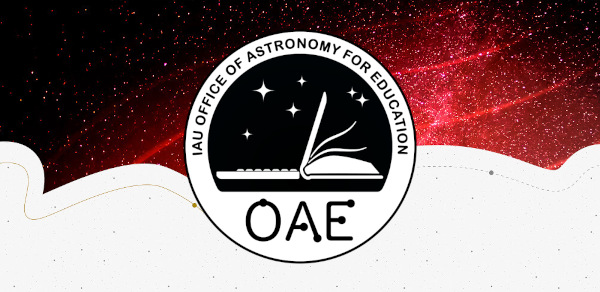This page describes a video Chilean Nights
Caption:
Honourable mention in the 2022 IAU OAE Astrophotography Contest, category Time lapses of celestial patterns.
Shot in December 2020, this time-lapse shows the sky from San Pedro de Atacama, Chile, in the southern hemisphere.
Right in the first frame we can see our home galaxy, the Milky Way, as well as both the Large and Small Magellanic clouds, two satellite galaxies orbiting the Milky Way. In the bottom of the image the bright stars Rigil Kentaurus and Hadar (also known as Alpha and Beta Centauri) are visible, both in the constellation Centaurus. Just above, we can also see the small constellation Crux, visible from the northern tropical circles southwards. It is important for navigation purposes because its longer axis indicates the direction of the celestial south pole. The bright whitish star in the top of the image and to the right of the Galaxy is Canopus, one of the brightest stars in the night sky, located in the constellation Carina. Canopus is the second brightest star in the sky, while Rigil Kentaurus is the third brightest.
In some of the next frames, Orion, the great hunter, appears clearly with its bright stars and its characteristic asterism, the belt, composed of three aligned bright stars. Since this video was taken from the southern hemisphere, the Greek hero from the northern hemisphere seems to be performing a headstand.
We can also see the planets Jupiter and Saturn in a close conjunction, even finding themselves in the significant beam of Zodiacal light setting down below the horizon. There are also a few meteors blinking in some of the frames, one of them with a long-lasting and developing trail. The very bright object rising from behind the volcanoes of the Andes, creating spectacular shadows and crepuscular rays, is the Moon. In the last frame we see the Moon next to Saturn and Jupiter.
Credit:
Robert Barsa/IAU OAE
DOI: 10.5281/zenodo.7425682
Related glossary terms:
Alpha Centauri
, Astronomical Observatory
, Constellation
, Large Magellanic Cloud (LMC)
, Milky Way
, Orion
, Small Magellanic Cloud (SMC)
Categories:
Galaxies
, Milky Way and Interstellar Medium
, Stars
, Telescopes, Instruments and Observatories
License: Creative Commons Attribution 4.0 International (CC BY 4.0) Creative Commons Attribution 4.0 International (CC BY 4.0) icons
The media file captions presented on the OAE website were written, translated and reviewed by a collective effort from the OAE, the OAE Centers and Nodes, the OAE National Astronomy Education Coordinators (NAECs) and other volunteers. You can find a full list of credits for our translation project here. All media file captions are released under a Creative Commons CC BY-4.0 license and should be credited to "IAU OAE". The media files themselves may have different licenses (see above) and should be credited as listed above under "credit".
Captions in Different Languages:
Caption: Lobende Erwähnung beim IAU OAE Astrofotografie-Wettbewerb 2022, Kategorie Zeitraffervideos von Himmelsmustern.
Dieses Zeitraffervideo wurde im Dezember 2020 aufgenommen und zeigt den Himmel von San Pedro de Atacama in Chile auf der Südhalbkugel.
Gleich in der ersten Szene sehen wir unsere Heimatgalaxie, die Milchstraße, sowie die Große und die Kleine Magellansche Wolke, zwei Begleitgalaxien, die die Milchstraße umkreisen. Im unteren Teil der Szene befinden sich die hellen Sterne Rigil Kentaurus und Hadar (die auch Bezeichnungen alpha und beta Centauri tragen), beide im Sternbild Centaurus. Ganz oben steht zudem das kleine Sternbild Crux, das Kreuz des Südens, das vom nördlichen Wendekreis nach Süden hin sichtbar ist. Es ist für die Navigation wichtig, da sein Längsbalken die Richtung des südlichen Himmelspols anzeigt. Der helle, weißliche Stern oben im Bild und rechts von der Milchstraße ist Canopus, einer der hellsten Sterne am Nachthimmel, der sich im Sternbild Carina befindet. Canopus ist der zweithellste Stern am Himmel, während Rigil Kentaurus der dritthellste ist.
In den späteren Szenen erscheint der große Jäger Orion deutlich mit seinen hellen Sternen und dem charakteristischen Gürtel, der aus drei aneinandergereihten hellen Sternen besteht. Da die einzelnen Sequenzen dieses Videos von der Südhalbkugel der Erde aus aufgenommen wurden, scheint der griechische Held der Nordhalbkugel einen Kopfstand zu machen.
Die Planeten Jupiter und Saturn sind in enger Konjunktion zu sehen und befinden sich zeitweise sogar im gut erkennbaren Lichtkegel des Zodiakallichts befinden, der am Horizont untergeht. In einigen Bildern blinken auch helle Meteore auf, einer davon mit einer langen und sich verändernden Spur. Das besonders helle Objekt, das hinter den Vulkanen der Anden aufsteigt und eindrucksvolle Schatten und Dämmerungsstrahlen erzeugt, ist der Mond. In der letzten Aufnahme sehen wir den Mond neben Saturn und Jupiter.
Credit: Robert Barsa/IAU OAE
Related glossary terms: Alpha Centauri , Astronomisches Observatorium , Kleine Magellansche Wolke (KMW) , Large Magellanic Cloud (LMC) , Milchstraße , Orion , Sternbild Caption translation status: Not yet approved by a reviewer
Caption translators: Carolin Liefke
Caption: Menzione d'onore al concorso di astrofotografia IAU OAE 2022, categoria Time lapses of celestial patterns.
Ripreso nel dicembre 2020, questo time-lapse mostra il cielo di San Pedro de Atacama, in Cile, nell'emisfero meridionale.
Nel primo fotogramma possiamo vedere la nostra galassia natale, la Via Lattea, così come la Grande e la Piccola Nube di Magellano, due galassie satelliti che orbitano attorno alla Via Lattea. Nella parte inferiore dell'immagine sono visibili le stelle luminose Rigil Kentaurus e Hadar (note anche come Alfa e Beta Centauri), entrambe nella costellazione del Centauro. Poco sopra, si nota anche la piccola costellazione della Crux, visibile dai paralleli dei tropici settentrionali verso sud. È importante per la navigazione perché il suo asse maggiore indica la direzione del polo sud celeste. La luminosa stella biancastra nella parte superiore dell'immagine e a destra della Galassia è Canopo, una delle stelle più luminose del cielo notturno, situata nella costellazione di Carina. Canopo è la seconda stella più luminosa del cielo, mentre Rigil Kentaurus è la terza.
In alcuni dei fotogrammi successivi, Orione, il grande cacciatore, appare chiaramente con le sue stelle luminose e il suo caratteristico asterismo, la cintura, composta da tre stelle luminose allineate. Poiché questo video è stato ripreso dall'emisfero meridionale, l'eroe greco dell'emisfero settentrionale sembra eseguire una verticale.
Possiamo anche vedere i pianeti Giove e Saturno in stretta congiunzione, nel significativo fascio di luce zodiacale che scende sotto l'orizzonte. In alcuni fotogrammi lampeggiano anche alcune meteore, una delle quali con una scia che si sviluppa a lungo. L'oggetto molto luminoso che emerge da dietro i vulcani delle Ande, creando ombre spettacolari e raggi crepuscolari, è la Luna. Nell'ultimo fotogramma vediamo la Luna accanto a Saturno e Giove.
Credit: Robert Barsa/IAU OAE
Related glossary terms: Alfa Centauri , Costellazione , Grande Nube di Magellano (LMC) , Orione , Osservatorio astronomico , Piccola Nube di Magellano (SMC) , Via Lattea Caption translation status: Approved by a reviewer
Caption translators: Valentina La Parola
Caption reviewers: Silvia Casu, Rodolfo Canestrari









